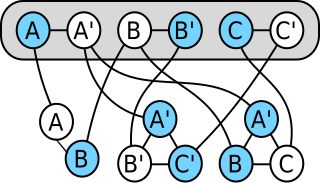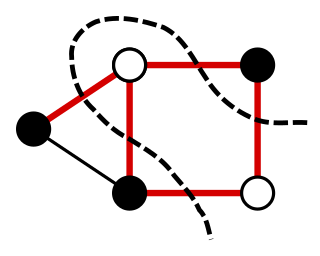
In computational complexity theory, NP-hardness is the defining property of a class of problems that are informally "at least as hard as the hardest problems in NP". A simple example of an NP-hard problem is the subset sum problem.

Combinatorial optimization is a subfield of mathematical optimization that is related to operations research, algorithm theory, and computational complexity theory. It has important applications in several fields, including artificial intelligence, machine learning, auction theory, software engineering, applied mathematics and theoretical computer science.

In graph theory, an independent set, stable set, coclique or anticlique is a set of vertices in a graph, no two of which are adjacent. That is, it is a set of vertices such that for every two vertices in , there is no edge connecting the two. Equivalently, each edge in the graph has at most one endpoint in . A set is independent if and only if it is a clique in the graph’s complement. The size of an independent set is the number of vertices it contains. Independent sets have also been called "internally stable sets", of which "stable set" is a shortening.
In computer science and operations research, approximation algorithms are efficient algorithms that find approximate solutions to optimization problems with provable guarantees on the distance of the returned solution to the optimal one. Approximation algorithms naturally arise in the field of theoretical computer science as a consequence of the widely believed P ≠ NP conjecture. Under this conjecture, a wide class of optimization problems cannot be solved exactly in polynomial time. The field of approximation algorithms, therefore, tries to understand how closely it is possible to approximate optimal solutions to such problems in polynomial time. In an overwhelming majority of the cases, the guarantee of such algorithms is a multiplicative one expressed as an approximation ratio or approximation factor i.e., the optimal solution is always guaranteed to be within a (predetermined) multiplicative factor of the returned solution. However, there are also many approximation algorithms that provide an additive guarantee on the quality of the returned solution. A notable example of an approximation algorithm that provides both is the classic approximation algorithm of Lenstra, Shmoys and Tardos for scheduling on unrelated parallel machines.
In computer science, a polynomial-time approximation scheme (PTAS) is a type of approximation algorithm for optimization problems.

In computability theory and computational complexity theory, a reduction is an algorithm for transforming one problem into another problem. A sufficiently efficient reduction from one problem to another may be used to show that the second problem is at least as difficult as the first.
The set cover problem is a classical question in combinatorics, computer science, operations research, and complexity theory. It is one of Karp's 21 NP-complete problems shown to be NP-complete in 1972.
MAX-3SAT is a problem in the computational complexity subfield of computer science. It generalises the Boolean satisfiability problem (SAT) which is a decision problem considered in complexity theory. It is defined as:
In computational complexity theory, Polynomial Local Search (PLS) is a complexity class that models the difficulty of finding a locally optimal solution to an optimization problem. The main characteristics of problems that lie in PLS are that the cost of a solution can be calculated in polynomial time and the neighborhood of a solution can be searched in polynomial time. Therefore it is possible to verify whether or not a solution is a local optimum in polynomial time. Furthermore, depending on the problem and the algorithm that is used for solving the problem, it might be faster to find a local optimum instead of a global optimum.
Interval scheduling is a class of problems in computer science, particularly in the area of algorithm design. The problems consider a set of tasks. Each task is represented by an interval describing the time in which it needs to be executed. For instance, task A might run from 2:00 to 5:00, task B might run from 4:00 to 10:00 and task C might run from 9:00 to 11:00. A subset of intervals is compatible if no two intervals overlap. For example, the subset {A,C} is compatible, as is the subset {B}; but neither {A,B} nor {B,C} are compatible subsets, because the corresponding intervals within each subset overlap.
In computational complexity theory, a PTAS reduction is an approximation-preserving reduction that is often used to perform reductions between solutions to optimization problems. It preserves the property that a problem has a polynomial time approximation scheme (PTAS) and is used to define completeness for certain classes of optimization problems such as APX. Notationally, if there is a PTAS reduction from a problem A to a problem B, we write .
In computational complexity theory, SNP is a complexity class containing a limited subset of NP based on its logical characterization in terms of graph-theoretical properties. It forms the basis for the definition of the class MaxSNP of optimization problems.

For a graph, a maximum cut is a cut whose size is at least the size of any other cut. That is, it is a partition of the graph's vertices into two complementary sets S and T, such that the number of edges between the set S and the set T is as large as possible. The problem of finding a maximum cut in a graph is known as the Max-Cut Problem.

In computational complexity theory, a problem is NP-complete when:
- a brute-force search algorithm can solve it, and the correctness of each solution can be verified quickly, and
- the problem can be used to simulate any other problem with similar solvability.
In computational complexity theory, a branch of computer science, the Max/min CSP/Ones classification theorems state necessary and sufficient conditions that determine the complexity classes of problems about satisfying a subset S of boolean relations. They are similar to Schaefer's dichotomy theorem, which classifies the complexity of satisfying finite sets of relations; however, the Max/min CSP/Ones classification theorems give information about the complexity of approximating an optimal solution to a problem defined by S.
In computational complexity theory, a gap reduction is a reduction to a particular type of decision problem, known as a c-gap problem. Such reductions provide information about the hardness of approximating solutions to optimization problems. In short, a gap problem refers to one wherein the objective is to distinguish between cases where the best solution is above one threshold from cases where the best solution is below another threshold, such that the two thresholds have a gap in between. Gap reductions can be used to demonstrate inapproximability results, as if a problem may be approximated to a better factor than the size of gap, then the approximation algorithm can be used to solve the corresponding gap problem.
In computability theory and computational complexity theory, especially the study of approximation algorithms, an approximation-preserving reduction is an algorithm for transforming one optimization problem into another problem, such that the distance of solutions from optimal is preserved to some degree. Approximation-preserving reductions are a subset of more general reductions in complexity theory; the difference is that approximation-preserving reductions usually make statements on approximation problems or optimization problems, as opposed to decision problems.
In computational complexity theory and combinatorics, the token reconfiguration problem is a reconfiguration problem on a graph with both an initial and desired state for tokens.
In network theory, the Wiener connector is a means of maximizing efficiency in connecting specified "query vertices" in a network. Given a connected, undirected graph and a set of query vertices in a graph, the minimum Wiener connector is an induced subgraph that connects the query vertices and minimizes the sum of shortest path distances among all pairs of vertices in the subgraph. In combinatorial optimization, the minimum Wiener connector problem is the problem of finding the minimum Wiener connector. It can be thought of as a version of the classic Steiner tree problem, where instead of minimizing the size of the tree, the objective is to minimize the distances in the subgraph.
The multiple subset sum problem is an optimization problem in computer science and operations research. It is a generalization of the subset sum problem. The input to the problem is a multiset of n integers and a positive integer m representing the number of subsets. The goal is to construct, from the input integers, some m subsets. The problem has several variants:








